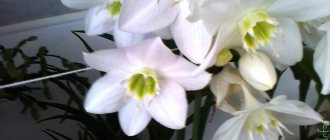Eucharis is a popular indoor plant with snow-white flowers not only in Russia, but throughout the world. This success is explained not only by the beauty of flowering and foliage during the dormant period, but also by the unpretentiousness and ease of reproduction. Despite its exotic origin, the flower is not too demanding on lighting and temperature, but we will learn from this article what kind of soil it prefers.
What composition is recommended for houseplants?
The soil for eucharis must have characteristics such as high nutritional value, looseness and moisture capacity, so that water does not accumulate inside the pot, and oxygen flows freely to the roots.
You can check whether the soil is suitable in this way: if the soil moistened and clenched in a fist sticks together into a lump, this soil is not suitable . When squeezed, the lump of earth should crumble and not stick together.
- The main components for the soil can be leaf soil, turf soil or black soil.
- Humus or compost is used to enrich it with useful substances.
- You can loosen it with coarse sand, peat or vermiculite.
- Charcoal is often used to disinfect soil: this helps avoid rotting.
The plant is not picky about soil acidity : slightly acidic (pH 5.1-5.8) or neutral (pH 6-7) soil is suitable.
ATTENTION! The flower should not be planted in alkaline soil and moistened with hard water. In this case, lime is released onto the surface of the earth, which does not allow oxygen and nutrients to pass through.
Reproduction methods
The flower can be propagated in two ways - by bulbs and seeds.
Children
This is the easiest way to reproduce. It is best to separate the children from the mother bush during transplantation - in early spring or autumn, but always during the period when the plant is dormant.
The separated children are transplanted into separate containers in nutrient soil. They are covered with film on top. Watering is carried out as needed. The first moistening of the soil is carried out no earlier than 2 weeks after planting. As soon as the first shoots appear, the film is removed.
Seeds
Eucharis ripens seeds, which, in theory, can be used for planting. But in practice this method is not used.
The percentage of seed germination does not exceed 5%. This method is used only by breeders when it is necessary to grow rare plant varieties.
How to prepare the soil yourself?
For mature plants
When making your own mixture for soil, you can use ingredients such as:
The proportion will be 1:2:1:1, or 3:1:1 in the absence of turf land.
There is another option for the composition of the mixture:
- 1 part leaf soil;
- 1/2 part of dry coconut substrate;
- 1/2 part sand.
Add half a glass of dry mullein or a glass of fresh horse manure to half a bucket of this mixture. To avoid possible fungal spores or pests, it is worth calcining all components in the oven for about 20 minutes at 200°C.
All ingredients should be mixed well, a medium fraction drainage made of pebbles, expanded clay, broken ceramics, coconut shells or small crushed stone should be placed on the bottom of the container, and already prepared soil should be placed on it.
IMPORTANT! When using fertilizers, it is necessary to avoid high nitrogen content due to its negative effect on the flowering of the plant.
For kids
For Eucharis children, the soil does not have excellent characteristics, however, in order for them to take root more quickly, some gardeners advise warming the soil to 25-30°C . It is better to plant up to five or six children at once in one (rather cramped) pot.
When it blooms
Depending on maintenance conditions, flowering may occur in spring, summer or autumn . Often, with proper care, eucharis blooms again during the season.
Well-developed, mature plants are capable of producing from 5 to 8 peduncles each and there will be several flowers at the top of each peduncle.
The first and most abundant flowering will occur in the autumn months or early winter, with a second wave appearing in late spring and early summer.
Each flower is able to maintain its attractiveness for 1 week , and each peduncle fades in about 3 weeks.
Transfer rules
Eucharis needs to be replanted no more than once every 3-4 years due to lack of space for the plant in the old pot.
REFERENCE! Remember that eucharis should not have a too spacious pot or a single planting: this may cause it to stop blooming. Therefore, plant transplantation does not involve complete separation of the children and the mother bulb.
More detailed information about transfer rules can be found in this article.
Bulb selection
Adult plants offered in flower shops are grown in a greenhouse and can adapt to home conditions for a long time.
Sometimes flower growers buy baby eucharis bulbs. You can find them for sale on flower forums, exhibitions or on Avito, from those who breed Amazonian lilies.
When choosing a bulb, pay attention to its condition. She must be:
- dense to the touch, without soft, rotten areas;
- covered with a light brown shell;
- intact, without dents or other damage.
Eucharis: signs and superstitions
Popular rumor generally notes the positive effect of eucharis on the energy in the house . According to the teachings of Feng Shui, the plant takes on all the negativity from the room and its inhabitants and fills the cleaned space with positive energy.
All presented types (photos and names) will help improve relationships between spouses and children. Eucharis has its maximum effect on household members during the flowering period: it restores mental balance and fills with strength.
There are signs associated with the state of the flower:
- The sudden wilting of the plant is associated with a strong negative flow from household members. This may be due to a serious conflict or a serious illness of one of the family members.
- The lack of flowering with proper care is also associated with unhealthy relationships in the family, where there is no mutual love and understanding.
- If 3 flowers bloom on a peduncle at once, then the family will soon expect an addition.
- In a wedding bouquet, eucharis (Amazon lily) serves as protection for the bride from envious people and the evil eye.
- In a home where there is a small child, the plant helps to reveal his talents, charge him with energy and creative inspiration.
Treatment of diseases
At the slightest deviation, the normal functioning of eucharis is disrupted - in the photo you can see the main diseases associated with an imbalance of watering and spraying.
First of all, the inflorescences are destroyed - the plant does not bloom for a long period - up to a year. Then the diseases spread to the root system, which dries out or, conversely, rots. At the same time, the leaves turn yellow and quickly fall off, normal reproduction becomes impossible, the number of shoots decreases, and after a certain time the eucharis dies.
Therefore, in order to get a beautiful flower at home, which can be seen in the photo, it will need very high-quality care.
You will need to frequently inspect the leaves and root system, identifying diseases in the early stages, and regularly replant and propagate in order to prevent depletion of the Amazon lily.
Of course, caring for it will take a lot of time and effort, but the result will be worth it in any case - after all, you will not be able to see such extraordinary delicate beauty anywhere else.
Description
According to the botanical classification, Eucharis does not belong to lilies at all, but to daffodils (Amaryllis family). It most often grows in groups , since the root system is bulbous and quickly forms daughter shoots.
The leaves are long, about 30 cm long and up to 15 cm wide. They are soft and thin, growing from a bulb on a long petiole, their top smoothly descends downwards. The leaf blades are painted dark green.
It can bloom twice a year , producing a long straight arrow. At its top, 3 or 6 white buds bloom. Their shape resembles a daffodil: 6 ovoid petals are located around a funnel-shaped core. The buds are large - for example, Eucharis grandiflora has a flower diameter of 15 cm .
Each Eucharis “lily” blooms for only a week, but thanks to the gradual opening of the buds, the total flowering period lasts up to 3 weeks.
Thermal mode
Favorable temperature for development and growth ranges from 25-30 degrees, further growth is not lower than 18 degrees.
The lily can withstand a drop of up to 15 degrees, but will bear little fruit in the future; at 11 degrees and below it dies.
Home care
Caring for eucharius does not require effort and comes down to following simple rules for maintaining a houseplant.
Lighting
The unpretentiousness of eucharis begins with lighting: the plant can bloom anywhere in the house. Even the location on the northern windowsill does not negatively affect the condition of the flower.
A sufficient amount of light for the plant will be provided on a western or eastern window . On the south side of the house, the flower should be kept half a meter from the window or shaded with curtains.
Temperature
Heat-loving eucharis is kept at a wide range of temperatures. In summer it can withstand thermometer readings up to 30 °C, and in winter – from 16 to 18 °C.
If the temperature drops to 15 °C, then eucharis loses the ability to flower for at least the next season. At temperatures below 10 °C, the bulb begins to rot, and the foliage begins to turn yellow and fall off.
It is recommended to transfer the plant to the summer temperature regime already in February , increasing the indicators to 21 ° C. Wintering should begin in October–November.
In winter, on a windowsill, the soil in a pot can cool more than the surrounding air, especially in regions with severe frosts. This promotes rotting of the bulbs, so it is better to move the plant away from the window. This measure will protect the eucharis from drafts during ventilation.
If it is not possible to put the pot away for the winter, then it should be wrapped on all sides with foil insulation, the shiny side out.
Watering
One of the problems that gardeners face when caring for eucharis is the watering regime. The plant can tolerate both short-term drought and waterlogging of the soil. But in the first case, you may not wait for flowering, and in the second, you may encounter fungal diseases and rotting of the bulbs.
The optimal method of watering is to moisten the half-dried top layer of soil . If Eucharis has limp leaves, then urgent watering or reducing the light intensity is needed. The volume of water is determined by the first drops from the drainage holes.
Before watering, the water is allowed to settle for 3 days or softened with apple cider vinegar (1 tsp per 1 liter of water). If this is not done, hard water will increase the alkalinity of the soil, and the plant will get sick. The water temperature is preferably slightly warmer than room temperature : the container can be placed to the radiator half an hour before watering.
Experienced gardeners recommend arranging conditions for the plant to rest - reducing watering to 2-3 times a month. Eucharis can be at rest from late autumn to the first days of spring. Frequent spraying stimulates the formation of new leaves , so the procedure can be carried out daily.
Pests
Indoor eucharis is sometimes attacked by pests. The following can live on the plant:
- Spider mite . The main sign of its presence is a web-like coating covering the lower parts of the leaves. Mechanical cleaning of the plant will help you cope with the mite: the leaves are wiped with a sponge soaked in a solution of laundry soap. Then the treatment is carried out with Actellik.
- Scale insects . A sign of damage is the appearance of plaques on the leaves and petioles. When there are a lot of pests, the leaves of the flower begin to turn yellow, dry out and fall off. To get rid of parasites, Fitoverm and Actellik are used.
- Thrips . Appear on the plant at elevated air temperatures and low humidity. They settle on the underside of leaves. Pierce the surface of the leaf and suck out the juice. The outer side of the leaves turns gray-brown. To control pests, all flowers and buds are picked off, and then the plant is treated with an insecticide (for example, Aktara).
Eucharis - home care
Eucharis is a member of the Amaryllidaceae family. The flower's homeland is South America, and it is most often found on the banks of the Amazon. The decorative flowering crop, also called the Amazon lily, was brought to the European continent in the mid-19th century. The plant quickly attracted the attention of flower growers.
More about the flower
A bulbous plant with dark green oval wide and long leaves that grow on petioles can bloom up to twice a year at home. The inflorescences, depending on the specific species, resemble lilies or daffodils. The attractiveness of eucharis lies not only in its high decorative value, but also in the fact that the culture grows safely at home for 15-20 years.
Flower care
The decorative flowering tropical line does not lose its foliage and even during the dormant period decorates the room, and when it begins to bloom, it fills the room with a subtle aroma. This is all true only when the plant is properly cared for.
Lighting
Tropical lily feels great indoors in partial shade. The flower can be safely placed on windows with a northern orientation. If the room is lit only from the south side, the pot of eucharis should not be placed on the windowsill, but on a bedside table or counter nearby. Active exposure to direct rays of the sun can leave burns on the leaf plate.
Temperature
The plant feels good all year round at temperatures of 18-25, but can easily tolerate increases up to 30 degrees Celsius. From October the temperature decreases, and by spring it begins to increase. It is not recommended to take the flower out into the open air. Temperature changes and drafts lead to irregular flowering and shredding of inflorescences. If the air does not warm up above 16 degrees Celsius, the lily may die.
Humidity
The Amazon lily prefers high levels of humidity. To create appropriate conditions, the air around the flowerpot is sprayed daily, with the exception of the flowering period. Drops falling on the petals can ruin the appearance of the inflorescences. Spraying can be replaced with a tray with moistened small stones, on which the pot is placed.
Watering
Stagnation of moisture leads to rotting of the bulb, but the flower also does not like drought. Eucharis should be watered when the top layer of soil dries out. It is best to use something like a ruler with a mark of about 2-3 cm. If, after lowering to the groove, the substrate ceases to be wet, water the plant. Take warm, settled water and pour it over the edge of the pot. The latter eliminates direct contact between the bulb and moisture.
Priming
Eucharis needs a nutritious and moisture-intensive substrate. Of the ready-made mixtures, any universal one for ornamental flowering crops, which is mixed with a small amount of charcoal and sand, is suitable. You can take ordinary garden soil if it is loose and fertile enough.
The soil is prepared independently from peat, leaf soil and sand, taken in a ratio of 1:3:1. Another option involves mixing equal parts of peat, leaf soil and sand, to which two parts of turf soil are added. Before use, the ingredients must be calcined for at least 20 minutes in the oven. It is better to take a ceramic pot rather than a plastic one, which will tip over under the weight of the onion. A two-centimeter drainage layer of broken bricks, ceramic shards, and pebbles is placed on the bottom of the container.
Problems you may encounter when growing Eucharis
The Amazon lily is not the most favorite flower among pests, but sometimes it gets its turn.
If the maintenance conditions are not met or there are infected flowers nearby, eucharis may suffer from:
- thrips (light spots on the upper part of the leaves and their darkening);
- spider mite (silver web on the back of the leaf, blanching and further falling of the leaves);
- mealybug (white flakes on the plant).
Special insecticide preparations (Aktellik, Decis) will help get rid of uninvited guests.
In addition, lilies are not immune to various fungi. Among the diseases of eucharis, the most common are:
- Gray rot. The leaves become soft and limp, darken at the edges and become covered with a gray coating. Cause: excess moisture at low temperatures. What to do: trim off all diseased areas, treat with copper-containing preparations, and ventilate more often.
- Stagonosporosis. Red oval spots appear on the leaves and they wilt. The flower stalks become crooked and the bulb rots. Reason: excess moisture, sudden temperature changes. What to do: remove all damaged leaves, treat with copper sulfate.
Also, if the eucharis bulb rots, this may be the result of overwatering. Lily does not tolerate waterlogging and will tolerate a lack of water better than its excess. It is urgent to remove the bulb, remove the rotten parts and treat it with a fungicide. It is better to replace the soil and reduce the frequency of watering in the future to prevent water stagnation again.
But, be that as it may, do not let possible problems and failures stop you from getting a house lily with wide leaves. The chic decorative appearance of a leafy rosette will decorate a room even when not in flower. And when tender buds appear, all doubts will be dispelled, and you will understand that this flower is really worth growing!











